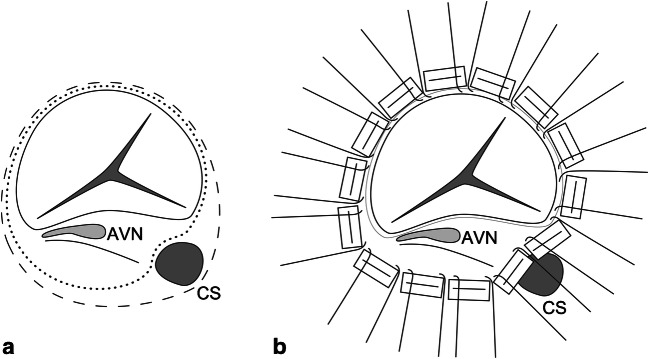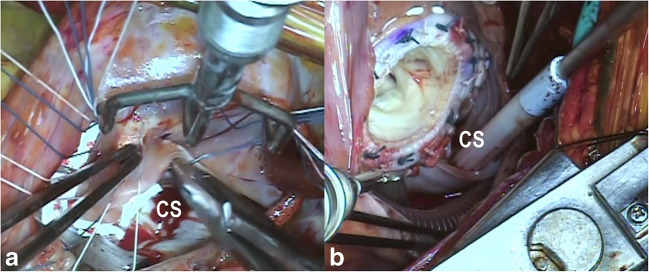Abstract
In conventional tricuspid valve replacement, there is a risk of valve detachment because stitches are placed on relatively fragile tissues. In the supra-annular implantation technique, stitches are placed lateral to the triangle of Koch and the coronary sinus instead of the anterior and septal leaflets as in conventional tricuspid valve replacement. This procedure relieves stress at the antero-septal commissural area, as well as avoids injury to the conduction system. However, there are a few drawbacks: (1) the valve sits obliquely at the annular surface, (2) the suture line becomes extremely long, and (3) the venous return to the coronary sinus may be impeded. We modified the suture line, which travels lateral to the triangle of Koch and medial to the coronary sinus, to solve these problems. We herein report the technique and results of four cases.
Electronic supplementary material
The online version of this article (10.1007/s12055-019-00905-z) contains supplementary material, which is available to authorized users.
Keywords: Tricuspid valve, Bio-prosthetic heart valve prosthesis, Coronary sinus
Introduction
In conventional tricuspid valve replacement (TVR), stitches are usually placed on the leaflet tissue at the antero-septal commissural area to avoid injury to the conduction system. However, there is a risk of valve detachment when stitches are placed on this relatively fragile tissue. Moreover, in cases of mitral/tricuspid double valve replacement, there may be atrio-ventricular block secondary to compression of the conduction system by the two implanted valves. Therefore, tricuspid valve supra-annular implantation (TVSI) is performed to avoid these risks. In contrast to stitch placement on the anterior and septal leaflets in conventional TVR, stitches are placed lateral to the triangle of Koch and the coronary sinus (CS) in the supra-annular technique. This procedure relieves stress at the antero-septal commissural area, as well as avoids injury to the conduction system. However, there are a few drawbacks: (1) the valve sits obliquely at the annular surface, (2) the suture line becomes extremely long, and (3) venous return to the CS may be impeded. To solve these problems, we modified the suture line, which travels lateral to the triangle of Koch and medial to the CS (modified TVSI or Matsuura-Saito procedure). We hereby report the technique and results of four cases.
Surgical technique (video 1)
Mattress, pledgeted 2-0 braided polyester sutures were placed from the right atrial wall toward the tricuspid annulus at the posterior and 4/5 of the anterior leaflet. A few stitches close to the antero-septal commissure were displaced cranially, lying just above the sinus of Valsalva. Placement of the stitches proceeded lateral to the tendon of Todaro and medial to the CS (Figs. 1 and 2). Usually, 13–17 mattress stitches are used to complete the suture line. A Mosaic valve (Medtronic Inc., Minneapolis, MN) was then implanted using these mattress sutures. In cases with a right ventricular lead, the lead was secured outside the bio-prosthesis at the postero-septal commissure.
Fig. 1.
a Suture lines in conventional TVSI (broken line) and in modified TVSI (dotted line). b Placement of mattress sutures in modified TVSI. AVN, atrio-ventricular node; TVSI, tricuspid valve supra-annular implantation; CS, coronary sinus
Fig. 2.
a A stitch is placed medial to the coronary sinus. b The coronary sinus is visualized. CS, coronary sinus
Table 1 shows the clinical summary of the four cases. Post-operative courses were uneventful in all cases. No case showed new atrio-ventricular block or new atrial tachycardia.
Table 1.
Clinical summary of four patients who underwent modified TVSI
| Case | Age | Gender | Disease | Implanted valve | Concomitant procedure | New AVB | New AT |
|---|---|---|---|---|---|---|---|
| 1 | 61 | F | TR, PLSVC, post-ASD closure | Mosaic (no. 33) | No | No | |
| 2 | 69 | F | TR, CAVB, post-AVR/MVR/pacemaker implantation (DDD) | Mosaic (no. 31) | – | No | |
| 3 | 60 | M | MR, TR, ischemic cardiomyopathy, post-PCI/CRT-D implantation | Mosaic (no. 31) | MVR | No | No |
| 4 | 85 | F | MR, TR | Mosaic (no. 31) | MVR | No | No |
ASD, atrial septal defect; AT, atrial tachycardia; AVB, atrio-ventricular block; CAVB, complete atrio-ventricular block; CRT-D, cardiac resynchronization therapy-defibrillator; PCI, percutaneous coronary intervention; PLSVC, patent left superior vena cava; MR, mitral regurgitation; AVR, aortic valve replacement; MVR, mitral valve replacement; TR, tricuspid regurgitation; TVSI, tricuspid valve supra-annular implantation
Comments
Dr. Shoichi Furuta introduced TVSI into clinical practice at the Mitsui Memorial Hospital (Tokyo, Japan) in 1975. Though TVSI was contrived in reference to TVR in Ebstein’s anomaly, it differs from TVR in that all leaflets are always preserved and stitches are placed in the anterior/posterior annulus instead of the right atrial wall [1, 2]. The results of 39 cases were first reported by our co-author Matsuura in 1988 [3]. In 2000, the results of the consequent 88 cases were reported from the same hospital [4]. TVSI was not widely applied although the results were excellent. The reasons for this include concern about detachment of the bio-prosthesis from the right atrial wall, as well as refusal to displace the CS towards the right ventricle. However, detachment of the bio-prosthesis was not reported in the two previously published studies [3, 4] (127 cases) and has not been observed in our 10-year clinical use of the procedure (5 conventional TVSI cases, 4 modified TVSI cases). Our modified TVSI technique dispels the latter concern regarding the CS. However, the development of an atrio-ventricular block has become a new concern because of the relatively close proximity to the conduction system compared with the conventional TVSI. Although a new atrio-ventricular block was not recognized in this series, the actual incidence remains unclear because one of four patients has already had a permanent pacemaker implanted for complete atrio-ventricular block. Moreover, the possibility of inducing a new atrial tachycardia upon placement of stitches at the isthmus between the tricuspid annulus and CS cannot be completely eliminated. However, this outcome was not experienced in any of our four cases.
With respect to the surgical technique, the stitches should not be placed deeply at the antero-septal commissural area to avoid injury to the sinus of Valsalva. Also, adequate distance between the suture line and the triangle of Koch should be maintained. Although we used a vertical left atriotomy approach for combined mitral valve replacement, a trans-septal approach is also possible. The use of a mechanical valve is not feasible for this procedure because the leaflet movement may be disturbed by the closely standing right atrial wall. Bio-prostheses with stiff stent posts should not be used because injury to the right atrial wall can occur. By paying ample attention to these points, modified TVSI can be performed safely.
Electronic supplementary material
Video clip of the surgical technique (WMV 36764 kb)
Compliance with ethical standards
All the authors state that there are no conflicts of interest. Additional informed consent was obtained from all patients for whom identifying information is included in this article.
Footnotes
Publisher’s note
Springer Nature remains neutral with regard to jurisdictional claims in published maps and institutional affiliations.
References
- 1.Dearani JA, Oleary PW, Danielson GK. Surgical treatment of Ebstein’s malformation: state of the art in 2006. Cardiol Young. 2006;16:12–20. doi: 10.1017/S1047951106000710. [DOI] [PubMed] [Google Scholar]
- 2.Dearani JA, Mavroudis C, Quintessenza J, et al. Surgical advances in the treatment of adults with congenital heart disease. Curr Opin Pediatr. 2009;21:565–572. doi: 10.1097/MOP.0b013e3283303fa7. [DOI] [PubMed] [Google Scholar]
- 3.Matsuura A, Abe K, Ino T, Wanibuchi Y, Furuta S. The surgical treatment of tricuspid insufficiency associated with acquired valvular disease--a comparative study of tricuspid annuloplasty and tricuspid valve supra-annular imposition. Nihon Kyobu Geka Gakkai Zasshi. 1988;36:1075–1081. [PubMed] [Google Scholar]
- 4.Ohata T, Kigawa I, Yamashita Y, Wanibuchi Y. Surgical strategy for severe tricuspid valve regurgitation complicated by advanced mitral valve disease: long-term outcome of tricuspid valve supra-annular implantation in eighty-eight cases. J Thorac Cardiovasc Surg. 2000;120:280–283. doi: 10.1067/mtc.2000.107486. [DOI] [PubMed] [Google Scholar]
Associated Data
This section collects any data citations, data availability statements, or supplementary materials included in this article.
Supplementary Materials
Video clip of the surgical technique (WMV 36764 kb)




